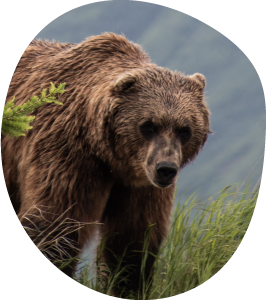WILD BEARS
There are only 8 species of bears that are still extant, however, they are widely distributed and can be found in a wide range of settings throughout the Northern hemisphere.
Although feared, bears are among people’s favourite wild animals. With the right choice of tour, it is possible to admire these animals ethically in their natural habitat with a positive conservation impact.
TOP BEAR-SEEING ETHICAL EXPERIENCES

JOIN A SVALBARD CRUISE
A cruise in Svalbard, Norway is a unique way to explore the Arctic while enjoying the opportunity to observe polar bears in their natural habitat.

OBSERVE BROWN BEARS IN ALASKA
One of the world's largest brown bear populations resides in Katmai National Park. Many of them frequent the area because they are attracted to the plentiful salmon in Brooks Falls.

GO TO THE 'POLAR BEAR CAPITAL OF THE WORLD'
Churchill, Manitoba is known for its large population of polar bears, and visitors from around the world come to see them in their natural habitat.

SUPPORT A SUN BEAR SANCTUARY
Located in Borneo, Malaysia, the Sun Bear Sanctuary is the first and only facility designed and built specifically for the rehabilitation of captive sun bears rescued from the illegal pet trade.

VISIT A PANDA CONSERVATION CENTER
The Chinese region of Chengdu is known as the "Panda Capital of the World" due to its numerous panda reserves and research centres. Thorough preliminary research is advised to avoid unethical experiences (eg. holding or petting the pandas).
Where to see wild bears?
ALL WILD BEAR BLOG ARTICLES & ETHICAL TOURS RECOMMENDATIONS
BROWN BEAR
The brown bear, also known as the ‘grizzly‘ in North America, is a large mammal, typically weighing between 200-600 kg. They are omnivores, which means they can be found foraging for roots, berries, and insects, as well as hunting for fish and small mammals.
SCIENTIFIC NAME
Ursus arctos
IUCN STATUS
Least concern
RANGE
Eurasia, North America
Featured articles ON BROWN BEAR >>
POLAR BEAR
Polar bears are the world‘s largest land–based carnivores and they are a majestic sight to behold. They are adapted to live in the Arctic, with thick fur, a layer of blubber for insulation, and large paws that enable them to swim, catch fish, and dig in the snow for food. It is estimated that there are around 22 000 to 31 000 polar bears in the wild.
SCIENTIFIC NAME
Ursus maritimus
IUCN STATUS
Vulnerable
RANGE
Arctic Circle, Canada
PANDA
The giant panda is native to central China and is one of the most recognizable species due to its unique black and white coat. This species has become a symbol of conservation efforts; habitat loss and low reproductive rates are among the main threats to their survival.
SCIENTIFIC NAME
Ailuropoda melanoleuca
IUCN STATUS
Vulnerable
RANGE
China
SUN BEAR
The sun bear is the smallest member of the bear family, with a body measuring up to 1.5 metres in length, and a weight of up to 65 kilogram. It is native to Southeast Asia and is easily identifiable by its brown or black fur, which is often lighter in color on the chest and legs.
SCIENTIFIC NAME
Helarctos malayanus
IUCN STATUS
Vulnerable
RANGE
South-East Asia




